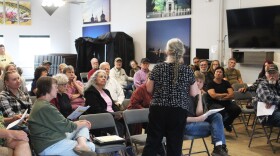The Kenai Peninsula Borough School District saw its peak in student population in 1998, but has declined by about 100 students per year ever since. District Superintendent Clayton Holland says that’s partially due to an increase of seniors citizens in the state.
“There is just an overall demographic shift on the Kenai Peninsula Borough," Holland said. "The number of students or children under age 10 is really the lowest of all the big regions.”
According to Alaska’s Department of Labor, the state’s 65 and older population increased by 4% between 2023 and 2024. But the number of kids up to age 17 decreased by 0.3%.
And that might not be the only factor contributing to a decrease in the school district’s enrollment. Affordable housing shortages have been well-documented across the Kenai Peninsula, and short-term rentals, like AirBnb, may be making the problem worse.
“It's hard to have employment and be able to be in the workforce if you can't make sure that there's a safe spot for your kid to be and a spot for you to live,” said Annaleah Karron, the school district’s college and career readiness coordinator.
Karron says the borough’s lack of childcare and healthcare options, compared to more populated regions, could also add to the school district's enrollment decline.
“When you lack those basic needs, you know, parents go elsewhere to be able to find those services,” Karron said.
The district is home to over 40 schools, and most have seen steady enrollment declines over the years. This means less funding is available for those schools.
K-12 Nikolaevsk School, on the southern Kenai Peninsula, has seen some of the district’s sharpest enrollment declines in recent years. The student population has dropped by more than half since the pandemic. To consolidate spending in light of the school district’s $17 million budget deficit the school board voted to close Nikolaevsk earlier this month.
Karron says school closures could mean less people contributing to the local economy.
“If a school in their neighborhood or in their community closes, that might mean that they transfer to home school, or that they leave the area entirely,” Karron said.
After a school closes, some students may opt for non-district homeschooling programs, which can impact KPBSD enrollment. But Karron says closures can also lead to more equipped schools, which might bring new students, and economic growth, to the peninsula.
“The argument has been made that by combining or consolidating schools, it actually provides more opportunities in those buildings," Karron said. "When you have more staff in a building, it means you can bring in electives like art, music and PE.”
Superintendent Holland says a key to increasing enrollment in KPBSD schools is promoting programs within them. He says talking with parents and teachers in the district can help.
“We have to promote our districts and create that trust," Holland said. "But, end of the day, it comes back to the people in your neighborhood and who you know personally.”
Despite enrollment decreases, Holland says the potential Alaska LNG Project could bring more families, and students, to the district.







